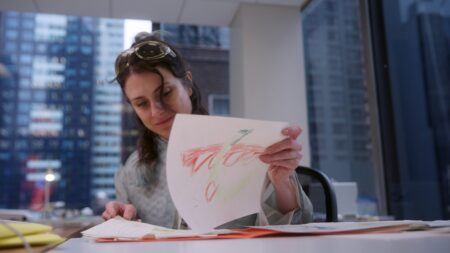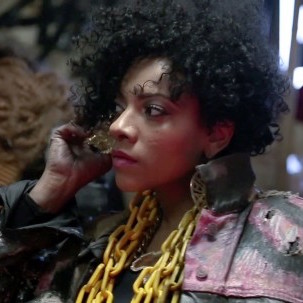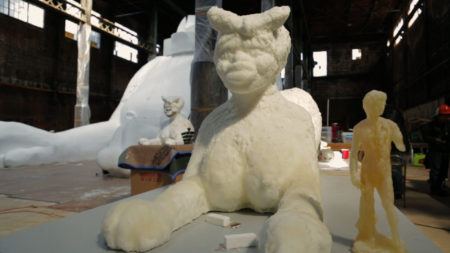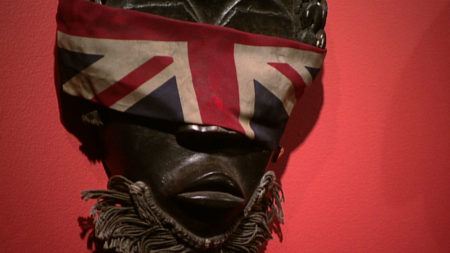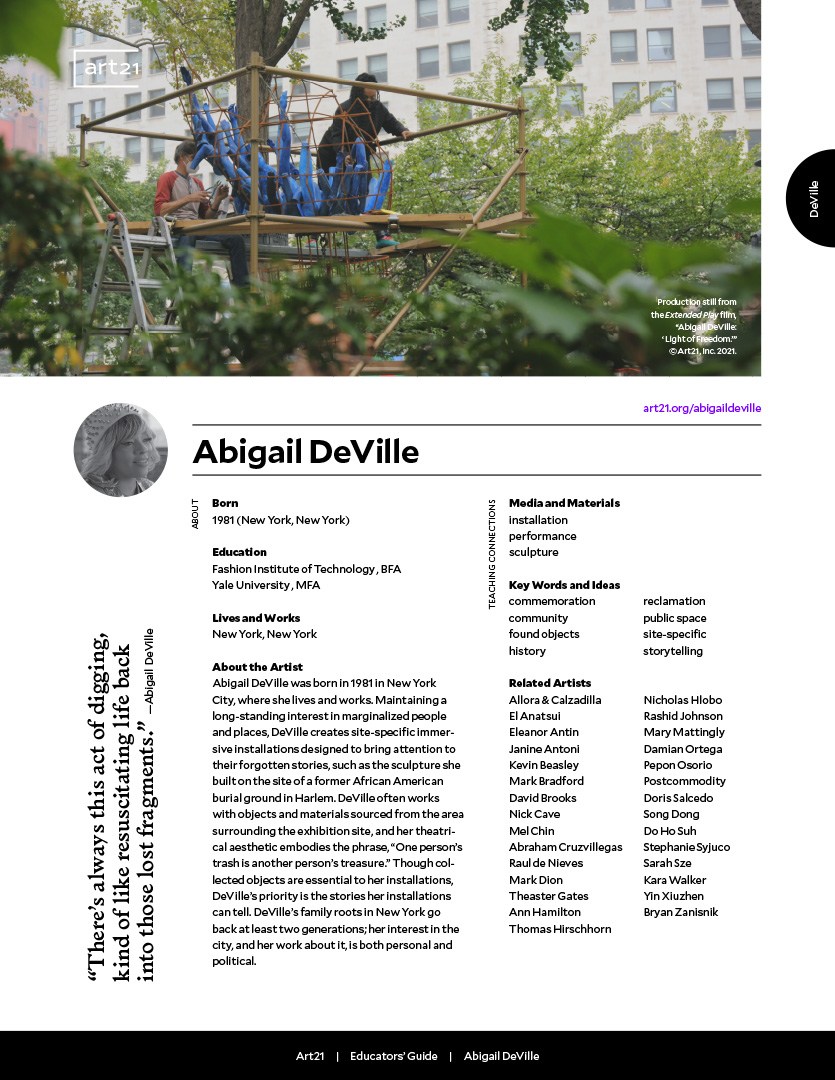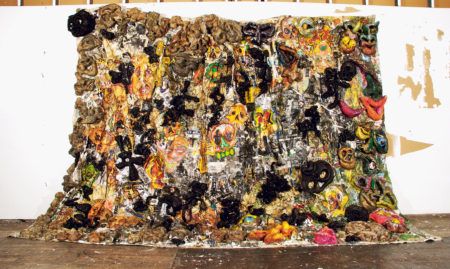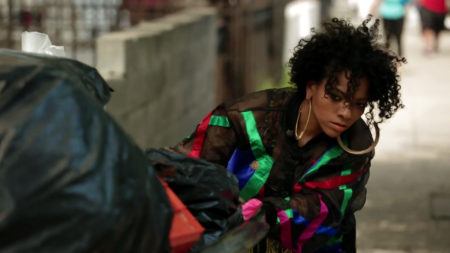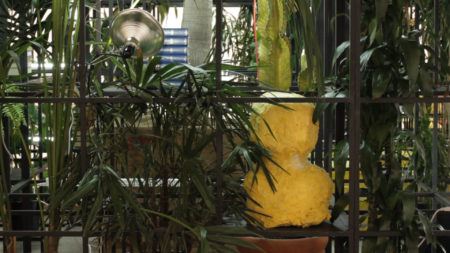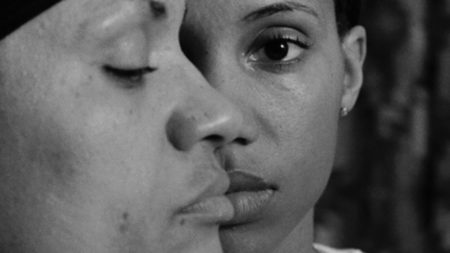Continue playing
(Time remaining: )
Play from beginning
Continue playing "{{ controller.videos[controller.getVideo(controller.currentVideo)].segmentParentTitle}}"
{{controller.videos[controller.getVideo(controller.currentVideo)].title}} has ended.
Abigail DeVille Listens to History
How does an artist express both the joy and pain in harrowing histories? Through her immersive performances and installation works, Abigail DeVille celebrates the bravery and optimism—while also memorializing the suffering—embedded within the African American experience. Calling out official American history as “garbage,” Deville uses discarded materials herself, like old furniture and tattered flags, to construct complex room-sized installations evoking the overlooked histories of Black Americans in all its messiness and grandeur. “There’s something, that if you’re quiet enough and you listen,” says the artist, “you’re being guided or directed to uncover specific bits of information.”
DeVille’s The New Migration, presented by the Studio Museum and staged on the streets of Harlem in 2014, was inspired by the women and men of the Great Migration—the millions of African Americans who escaped the systemic racism and state violence of the Jim Crow South in the twentieth century. Directed by collaborator Charlotte Brathwaite and also performed in Anacostia and Baltimore, The New Migration is a grand on-the-street procession of musicians, dancers, marching bands, and community members of all ages donning DeVille’s wearable sculptures, which for the artist signify the weight of history.
The project also references the current gentrification of American cities like Harlem and Chicago as the next migration forcing communities of color from their homes. A reckoning facilitated through festivity, DeVille’s collaborative community performance honors the agency and hope of Black communities today. “It’s something for me to constantly be reminded of,” says DeVille, “that we as a people, we’re going to get there.”
Featuring the artist’s installation Only When It’s Dark Enough Can You See the Stars at The Contemporary, Baltimore; and the artist’s 2014 Anacostia performance hosted by the Anacostia Arts Center. Locations include The National Great Blacks in Wax Museum. Also featuring music by Artem Bemba, Burnt Sugar the Arkestra Chamber, Cloudjumper, Jade Hicks, Justin Hicks, Kenita Miller-Hicks, New Edition Legacy Marching Band, and Pedro Santiago.
Credits
New York Close Up Series Producer: Nick Ravich. Director & Producer: Wesley Miller. Editor: Anna Gustavi. Cinematography & Sound: Amitabh Joshi, Paul Lieber, John Marton, Michael T. Miller, Wesley Miller, Cauleen Smith, Think Out Loud Productions. Music: Artem Bemba, Burnt Sugar the Arkestra Chamber, Cloudjumper, Jade Hicks, Justin Hicks, Kenita Miller-Hicks, New Edition Legacy Marching Band, Pedro Santiago. Design & Graphics: Open, Uros Perisic. Archival Photography: Library of Congress, Prelinger Archives. Artwork Courtesy: Abigail DeVille. Performance Co-Creator & Director: Charlotte Brathwaite. Performers: M. Liz Andrews, Mikel Banks, Asim Barnes, Flip Barnes, JM Denson, Avram Fefer, Asma Feyijinmi, Daniela Fifi, Paula Henderson, Ayesha Jordan, Ifasen Kwame, Shango Kwame, André Lassalle, Hiroyuki Matsuura, Nina Angela Mercer, Candace Mickens, Paul Pryce, Sheldon Scott, Jessica Silva, André D. Singleton, Greg Tate, Ibrahim Turay, LaFrae Sci, Ayinde Utsey. Thanks: Rushern Baker IV, Kent Barrett, Holly Bass, Asha Elana Casey, The Contemporary, Peggy Cooper Cafritz, Oscar Cornejo, Sandra Cornejo, DC Commission on the Arts & Humanities, Stephen Crouch, Jessica Denson, The DeVille Family, David O. Fakunle, Catherine Feliz, Arianne Gelardin, Jackson Gilman-Forlini, Angela Goerner, Deana Haggag, Jennifer Harrison Newman, Lauren Haynes, Lee Heinemann, Ariel Jackson, Amanda Jiron-Murphy, Anthony Joshua, Nathan Lewis, The Loading Dock, Deirdre Ehlen MacWilliams, Samuel Margai, Dr. Joanne Martin, Michael Metcalf, MICA, Kenita Miller, Morris-Jumel Mansion, National Great Blacks in Wax Museum, Jared M. Nickerson, Mary Olin Geiger , The Peale Center for Baltimore History & Architecture, Philip A. Robinson, Terry Scott, Jazmin Smith, Ginevra Shay, The Studio Museum in Harlem, Monica Utsey, Kimberly J. Wade, Nico Wheadon.
New York Close Up is supported, in part, by The Lambent Foundation; public funds from the New York City Department of Cultural Affairs in partnership with the City Council; and by individual contributors.
Closed captionsAvailable in English, German, Romanian, Italian, Japanese, Korean, Chinese, Italian
Through the Art21 Translation Project, multilingual audiences from around the globe can contribute translations, making Art21 films more accessible worldwide. Translate this video now.
Interested in showing this film in an exhibition or public screening? To license this video please visit Licensing & Reproduction.
Abigail DeVille was born in 1981 in New York, where she lives and works. Maintaining a long-standing interest in marginalized people and places, DeVille creates site-specific immersive installations designed to bring attention to these forgotten stories. DeVille often works with objects and materials sourced from the area surrounding the exhibition site. Though collected objects are essential to her installations, DeVille’s priority is the stories her installations can tell. DeVille’s family roots in New York go back at least two generations; her interest in the city, and her work about it, is both personal and political.
“When things are painful, people don’t want to talk about them. But we can’t forget about the class of invisible people that were present at every single moment in the formation of this country and its myths.”
Abigail DeVille
History Reimagined
Kara Walker
Eleanor Antin
Fred Wilson
Educators' Guide: Abigail DeVille
The questions and activities included in this guide are recommendations for incorporating Art21 films featuring Abigail DeVille into your classroom.
